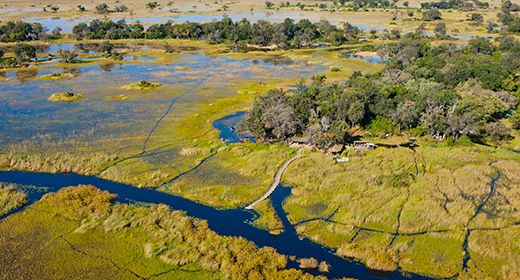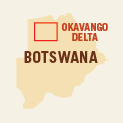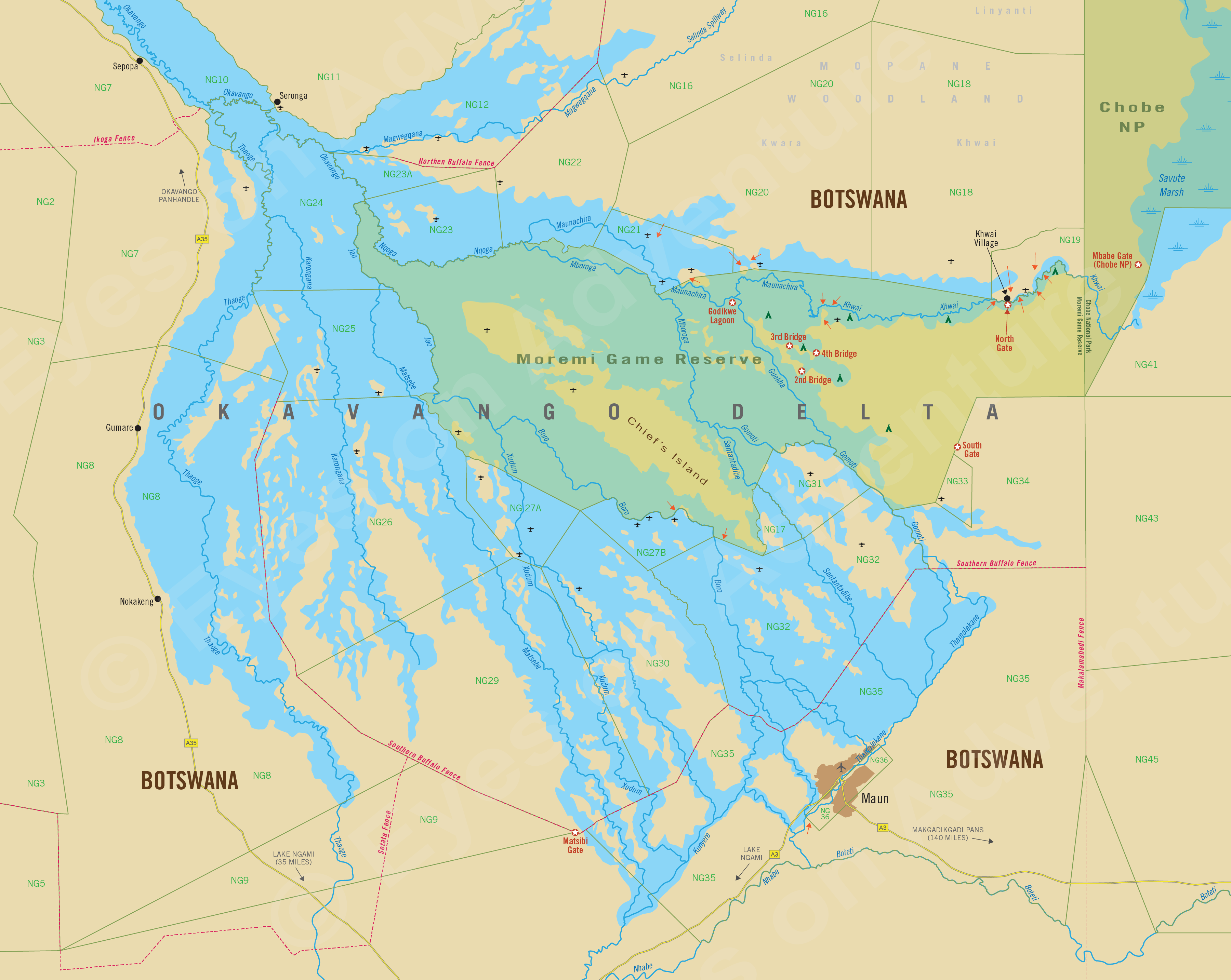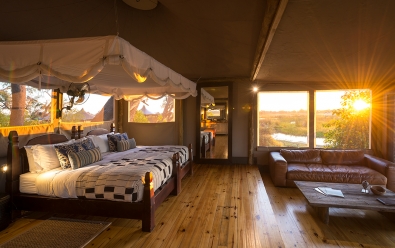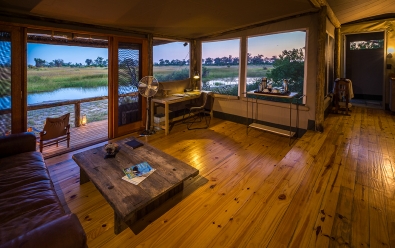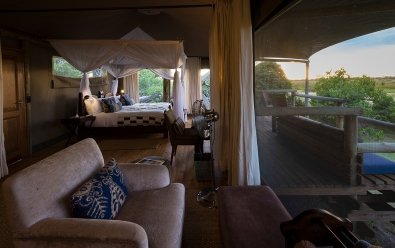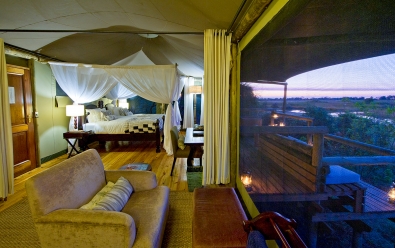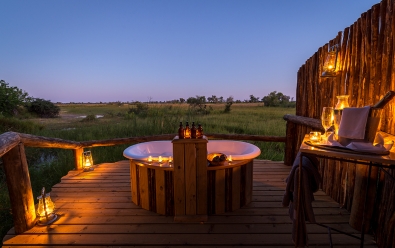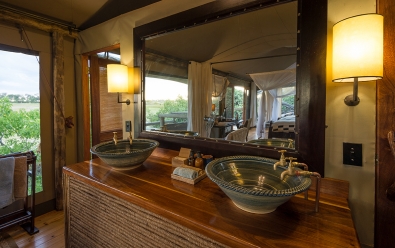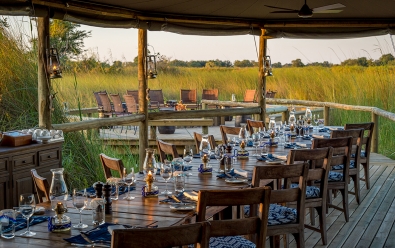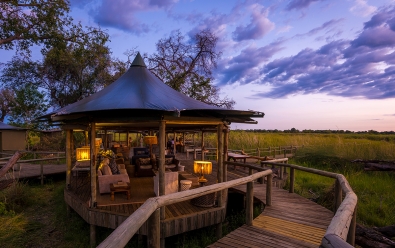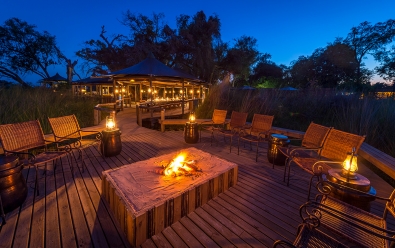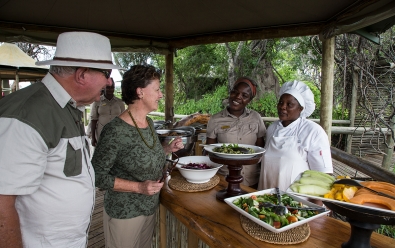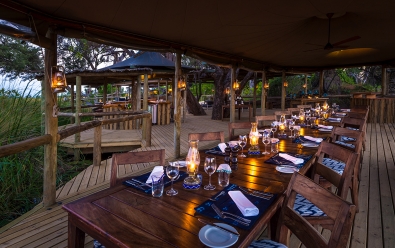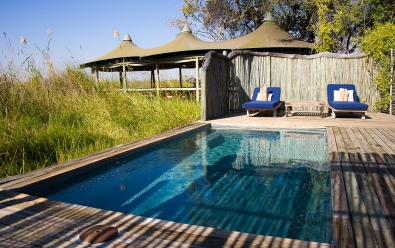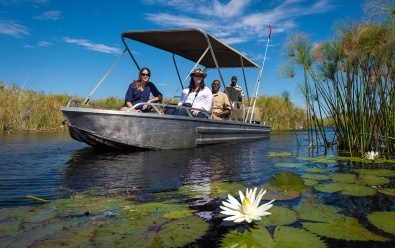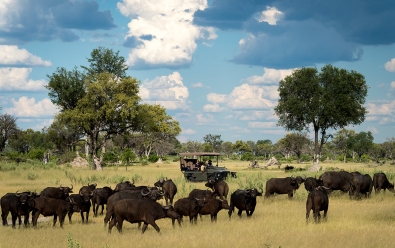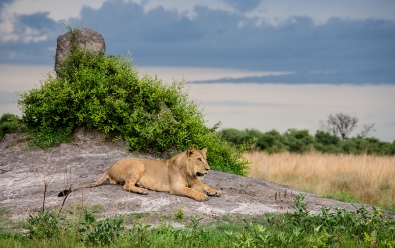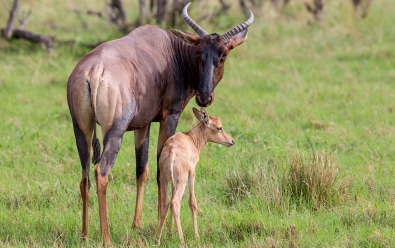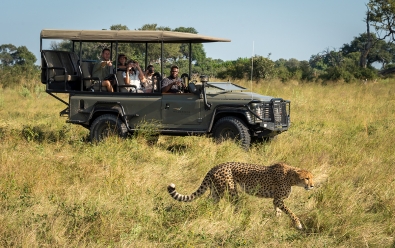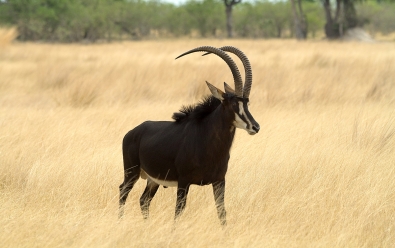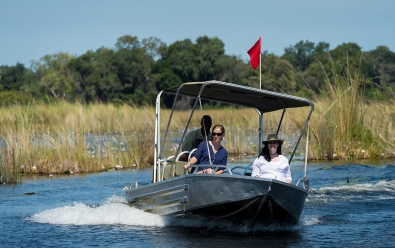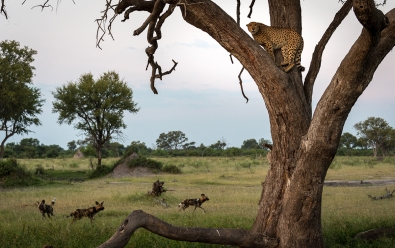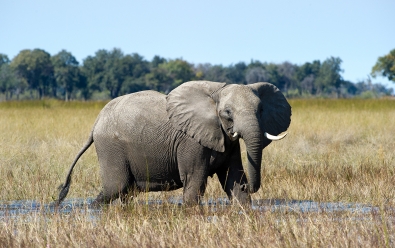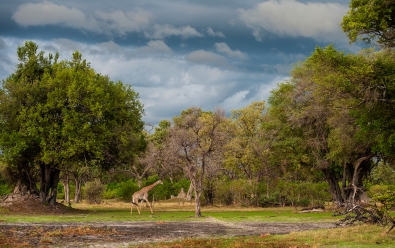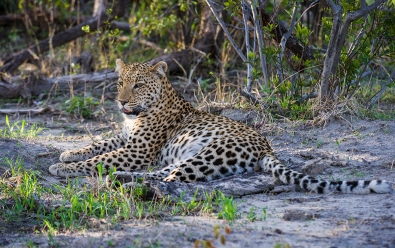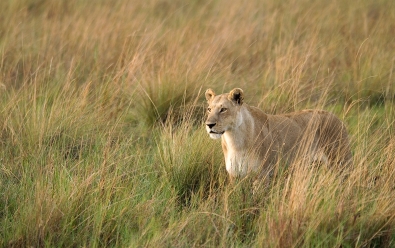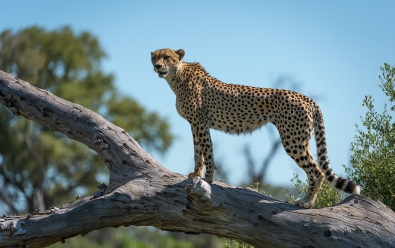Little Vumbura Camp
Highlights
- Diversity of habitats and wildlife, including sable antelope
- Offers activities on land, water, air (hot-air balloon; seasonal)
- Good variety of predators and plains game species
- Traditional 'classic'-style camp offering comfort and excellent service
Location
- NG22 Private Concession
- Northern Okavango Delta
- Northern Botswana
Little Vumbura is a small, classic-style safari camp on the northern edge of the Okavango Delta, in an area offering prolific and diverse wildlife with year-round land- and water-based activities.
The camp is located within the 230-square-mile (600-sq-km) Kwedi concession, which borders the Moremi Game Reserve to the north. Little Vumbura is situated on a small, wooded island and is accessible only by boat, the epitome of island living in the midst of the Delta. The camp offers a diverse safari experience, including safari game drives, mokoro (traditional dugout) excursions, boating, nature walks, seasonal fishing (catch-and-release), and seasonal hot-air balloon rides.

Main area at Little Vumbura Camp.
Common predators that are seen regularly at Vumbura include, lion, leopard, African wild dog, cheetah, spotted hyena, and black-backed jackal. Hippo and crocodile are abundant in the waterways. The diverse habitats in the concession make for an incredibly good birding experience, with large numbers of both dryland species and waterbirds present.
Little Vumbura Plains includes just 6 guest tents (one of which is a double/family unit). The tents are connected to the camp's main area by sandy footpaths. The tents are comfortable, with en-suite facilities and decorated in a traditional safari style.
Wilderness Safaris are one of Africa's leading safari operators and they strive to minimize energy consumption at all their camps. Little Vumbura Camp is powered by a hybrid system, which combines solar power and a diesel-powered generator. The hot water is heated by thermodynamic geyser.
Strict eco-friendly environmental standards are maintained so that no harmful chemicals or waste is allowed to enter the pristine ecosystem of the Okavango Delta.
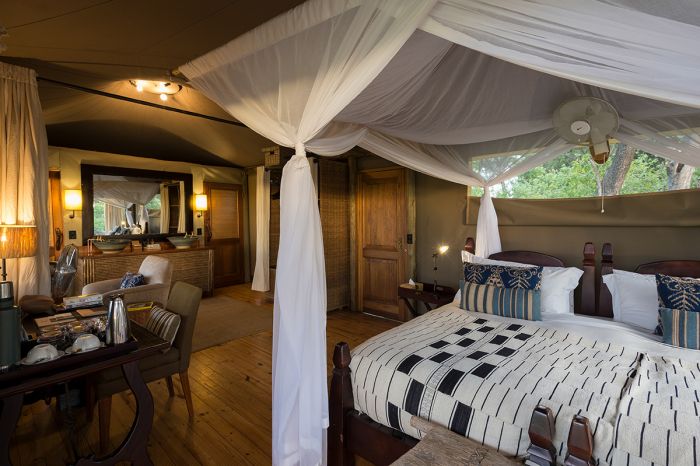
Guest tent interior at Little Vumbura.
The Kwedi concession includes a wide range of habitats, including Acacia woodland, mopane woodland, Kalahari apple-leaf scrub, seasonally flooded grasslands, papyrus and reed beds bordering permanently open waterways and lagoons, and palm-fringed islands. The land is leased from five small villages, providing revenue and jobs to the local people and helping promote the benefits of ecotourism to the rural stakeholders.
This area is home to the highest antelope diversity in the Okavango, as well as abundant predators. Commonly seen wildlife includes elephant, plains zebra, greater kudu, blue wildebeest, red lechwe antelope, buffalo, impala, tsessebe, common waterbuck, common reedbuck, giraffe, and warthog. Vumbura is also the best place in northern Botswana to see the regal and spectacular sable antelope.
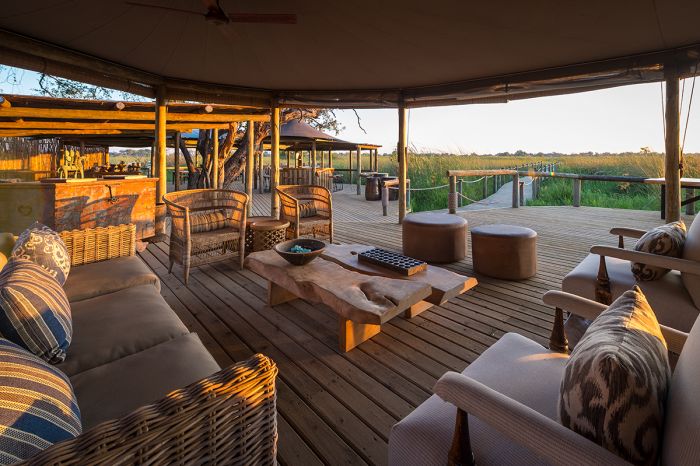
Main area and view to the jetty at Little Vumbura.
About the Okavango Delta
The Okavango Delta is one of Africa's greatest safari destinations and offers an incredible diversity and abundance of wildlife. The Okavango is an UNESCO World Heritage Site as well as a Ramsar Wetland of International Importance.
Often referred to simply as "the Delta", the Okavango is characterized by an ever-changing network of waterways that originate far to the northwest in the highlands of Angola. The Cubango River flows into northern Botswana and spills into the flat expanse of Kalahari sands, where it fans out into a shallow trough formed by tectonic faults beneath the sand.
The annual 'flooding' of the Okavango brings in rich sediments that provide nutrients atop the sands, which in turn creates a diverse ecosystem of permanent and seasonal waterways, deep-water lagoons, papyrus beds, palm-covered islands, seasonally flooded grasslands, and woodlands. The rich fresh-water environment changes year-to-year depending on the level of the floodwaters making it one of the most dynamic wildlife destinations on Earth.
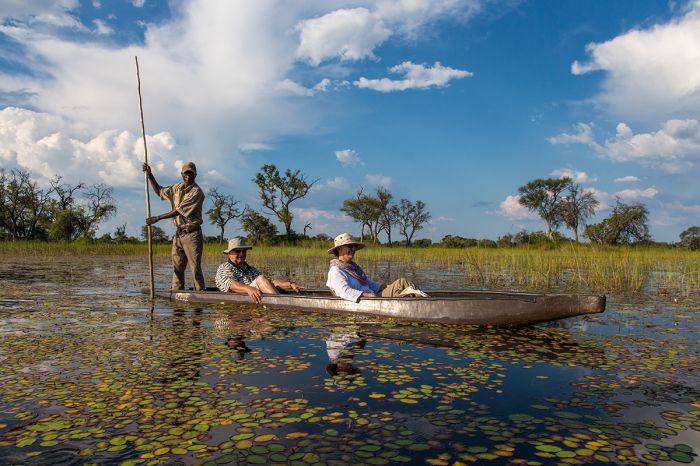
Mokoro safari at Little Vumbura.
Wildlife in the Okavango Delta is diverse and includes all of Africa's Big Five animals (lion, leopard, elephant, rhino, and buffalo. Commonly seen herbivores include giraffe, plains (Burchell's) zebra, blue wildebeest, impala, tsessebe, common reedbuck, greater kudu, waterbuck, buffalo, elephant, and warthog. Both species of rhino are found, albeit in small numbers. The Delta is also home to red lechwe and sitatunga, both of which are water-dependent antelopes.
The abundance of herbivores means that predators are common in the Okavango. Commonly seen species include lion, leopard, spotted hyena, black-backed jackal, and African wild dog. Cheetah are sometimes seen in the larger grasslands like those on Chief's Island. Less frequently encountered predators include serval, caracal, honey badger, and various species of mongoose.
The abundance of water in the Okavango provides habitat for Nile crocodiles and hippos, both of which are seen easily at any of the safari camps located near the Delta's permanent water. Primates in the Delta include chacma baboon, vervet monkey, and bush baby (galago).
Birding is outstanding in the Delta, with over 400 species possible. A typical safari day can easily produce over 100 species for an avid birder.
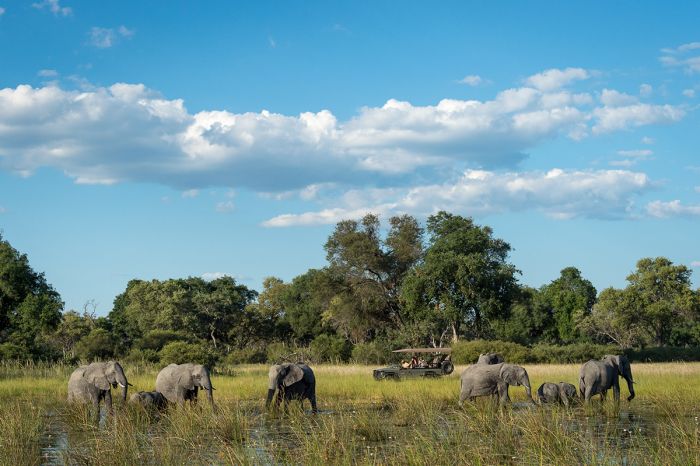
Game drive and elephants at Little Vumbura.
ROOMS INCLUDES & EXCLUDES CHILDREN FACILITIES ACTIVITIES
Accommodation
6 guest accommodations in total comprising:
- 5 twin-bedded wood and canvas tents, each with two three-quarter beds (separate mattresses with shared base) and outdoor deck. Mattress converters are available that transform the twin beds into king-size beds. To be arranged prior to arrival.
- 1 wood and canvas family unit consisting of two connected tents, each with two three-quarter beds (separate mattresses with shared base) and each with its own en-suite facilities. The main bathroom and second bathroom each have an indoor shower (no outdoor shower), double-basin vanity, and separate toilet. There is a shared entrance, outdoor deck and indoor sunken lounge. While the main bedroom can be converted into a king-size bed, the second bedroom is a permanent twin.
The tented accommodations are constructed on a raised wooden deck with sandy pathways leading to the main camp area. All tents have verandas overlooking the surroundings.
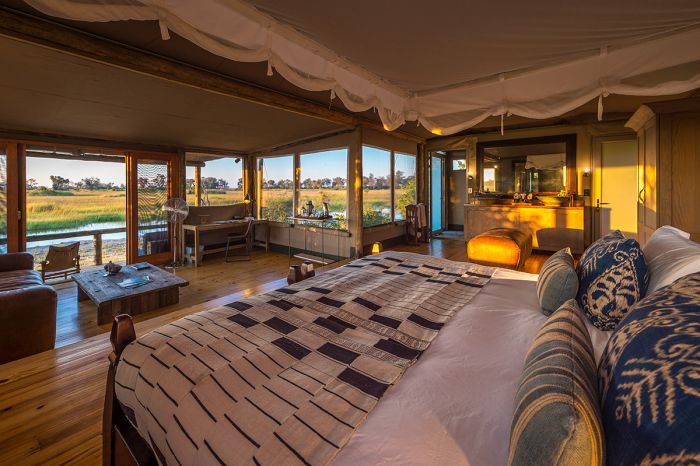
Guest tent interior and view.
Each guest tent has an indoor shower and separate toilet (one unit also has an outdoor bath on a private deck), double-basin vanity, and a sunken indoor lounge area including a writing desk.
Other items and features in the guest tents include:
- Mosquito net.
- Veranda with deck chairs.
- Pedestal fan and wall-mounted fan.
- Electronic safe.
- Tea and coffee making facilities (hot water provided on request).
- Hairdryer.
- Yoga mat.
- Free weights (2x 1-kg and 2x 2-kg) and resistance bands.
- In-tent Wi-Fi.
- During the winter months, hot water bottles and extra blankets are provided.
- Personal amenities, including bathrobes, slippers, hand and body wash, shampoo and conditioner, skin lotion, insect spray, shower caps, vanity kit with cotton wool pads and swabs, sewing kit, tissue dispenser, washing powder, umbrellas, mosquito repellent spray, and mosquito coils.
Little Vumbura Camp can accommodate a maximum of 14 guests in total: 2 persons in each of the 5 guest tents and 2 adults plus 2 children in the family unit.
Includes & Excludes
Includes:
- All meals and local beverages including wines, spirits and liqueurs, but excluding premium imported brands and Champagne.
- Twice-daily safari drives in open game-viewing vehicles and other scheduled camp activities (accompanied by experienced guides).
- Laundry services are provided on a daily basis (weather permitting, items will be returned on the same day). Laundry is dried by the sun and on most days any laundry placed out in the morning will be returned by the evening. Environmentally friendly detergent is available in the rooms or can be provided on request.
- Wi-Fi access.
- Tourism Levy & VAT.
Excludes:
- Purchases from the Safari Trading Store.
- Premium imported beverages and Champagne.
- Hot-air balloon outings (details under Activities below).
- Scenic helicopter flights ranging in duration from 30, 45 to 60 minutes - with a minimum of 2 guests and a maximum of 5 or 6 depending on the helicopter used (morning or afternoon).
- Tsodilo Hills (UNESCO World Heritage Site) excursion to learn more about Botswana and the history of the San people - with a minimum of 2 guests and a maximum of 10 (via scenic helicopter flights only).
- Any applicable wildlife fee, park fee, reserve fee, concession fee, other land-use fee.
Single Supplement
A single supplement will apply for any room booked by a single traveler; please ask us for pricing.
Children
Children aged 6 years and older are accommodated at Little Vumbura:
- For families traveling with children between 6 and 12 years, private activities must be booked and paid for.
- Children between 6 and 16 years must share with an adult/s in the same room.
- The minimum age for boating activities is 6 years (water levels permitting).
- The minimum age for mokoro activities is 13 years (water levels permitting).
- The minimum age for walking (seasonal and subject to the availability of a qualified walking guide) is 13 years.
- The minimum age for hot-air ballooning is 7 years and a parent or guardian must accompany any child under 16.
Facilities
The main area is constructed atop a wooden deck with a canvas roof and encompasses a lounge, dining area, bar, and an outdoor fire deck.
Additional main guest area facilities include:
- Traditional boma for dining under the stars.
- Safari Trading Store.
- Reading area with a selection of reference books.
- Pool and reading area overlook the floodplains.
- Star deck leads off the dining area.
- Floating jetty with motorized boats (4x4 safari vehicles are reached via a short boat ride).
Activities
Activities included in the rate:
- Day safari drives in 3x 10-seater open 4x4 Land Cruisers.
- During winter months hot water bottles (on early morning game drives only), blankets, and lined ponchos are provided.
- A pair of Olympus binoculars is available in each of the game drive vehicles for guests to share amongst themselves while game viewing and may be requested from our guides.
- The camps have a supply of bean bags for guests to use to steady their camera while on game drive.
- Water-based activities in 6x 2-seater mokoro (traditional dugout canoe), 2x 8-seater motorized boats, and 2x 6-seater motorized boats (water levels permitting).
- Fishing on a catch-and-release basis year round (except January and February when fishing is barred by law for breeding).
- Guided nature walks (seasonal and subject to the availability of a qualified walking guide, therefore pre-booking is essential).
- Birding.
- Wilderness Safaris and Olympus Photo Hub experience.
Optional activities at additional cost:
- Private activities are on offer (subject to vehicle availability which needs to be booked in advance).
- Hot air ballooning (weather permitting). Transfers to the launch site are via direct helicopter flight only, while the return to camp can be via game drive (cost included) or 30-minute scenic helicopter flight (at additional cost) at guest’s choice.
- Scenic helicopter flights ranging in duration from 30, 45 to 60 minutes - with a minimum of 2 guests and a maximum of 5 or 6 depending on the helicopter used (morning or afternoon).
- Tsodilo Hills (UNESCO World Heritage Site) excursion to learn more about Botswana and the history of the San people - with a minimum of 2 guests and a maximum of 10 (via scenic helicopter flights only).
Example of a typical day:
- Early morning wake-up call. Morning wake-up and activity times vary according to the seasons, activities on offer, and wildlife sightings.
- Light breakfast before departing on the morning activity.
- Return to camp for a meal and rest period.
- Meet for afternoon tea and snacks (savory and sweet choices) before departing on the activity.
- Return to camp - freshen up or meet for drinks, followed by dinner.
- Enjoy a nightcap or discussion around the fire before retiring.
Great Good Fair Poor
- Jan
- Feb
- Mar
- Apr
- May
- Jun
- Jul
- Aug
- Sep
- Oct
- Nov
- Dec
WHEN TO GO
The Okavango Delta offers very good wildlife viewing opportunities all throughout the year, but there are seasonal variations in terms of weather that may be a consideration when planning your visit.
The high season in terms of tourist demand is during the dry months between June and October. The latter part of the rainy season is the low season.
The winter (June through August) is dry and cool and wildlife may be easier to find as rain water is evaporating and the rivers and deeper waterholes become more frequently visited by the animals.
During the middle and later stages of the rainy season, the grass becomes tall and the bush becomes lush and thick, which makes for lovely colors, but makes spotting wildlife more difficult.
Little Vumbura Camp is open year-round.
Summer / Rains
Northern Botswana, including the Okavango Delta receives most of its rain between December thru February, which is the summer season. November and December are wonderful months to visit the Delta, with only occasional rainstorms and most rain coming in short showers, which bring relief to the thirsty land after the dry season.
January and February typically experience afternoon downpours on most days, but all-day rain is very uncommon. By the middle of March, the rains become much less frequent and the grass and bush have grown long and thick. Mornings become cooler by the end of March.
In spite of being summer, the rains keep temperatures from becoming overly hot, although humidity and insect life are at their peak. Days are mostly overcast or partially cloudy, with dramatic skies and a lovely green color to the landscape. Afternoon temperatures average 88°F (31°C), but mornings are very comfortable at around 65°F (19°C).
Baby animals are in abundance, especially impala lambs and warthog piglets. Migratory birds arrive to breed and dramatically increase the number of species and overall numbers, particularly in the lagoons and pans, which are full of rain water and food for the aquatic species.
Unlike the dry months (May through October), when the middays can be very warm, causing wildlife to minimize activity and seek shade from around 10am til mid-afternoon, the overcast skies in the summer often mean that animals are active throughout the day, offering many more hours of game viewing.
Autumn
March, April and May are Fall season months and the beginning of the dry season in the Okavango, with rains very uncommon from around mid-March. The landscape is still lush and green, with sunny days and comfortable temps; afternoons average 84°F (29°C). Mornings are comfortable, but a fleece and base layer may be needed for the first hours on game drive.
Migrant birds fly north and water in the lagoons and rain pans is drying up. Permanent waterways in the Delta are however rising, as the 'flood' water from the Angolan highlands is now reaching the Delta.
Morning temps are around 54°F/12°C and afternoons average 79°F/26°C.
Winter / Dry Season
June through August is winter and the vegetation is drying and going dormant. The Okavango flood water is peaking but the surrounding landscape is mostly brown and yellow. Dust and sand particles in the air is on the rise. Game viewing is superb, with elephant and buffalo herds congregating along permanent water.
Mornings can be chilly to very cold at around 45°F (7°C). Warm clothes, including winter hat and gloves are needed for the open-air game drives. Dress in layers, as the temps do rise quickly during the day, with middays reaching 79°F (26°C).
Spring
September and October are the driest months as the landscape and animals eagerly await the coming rains. Game viewing is phenomenal, with all lagoons and rain pans completely dry and animals congregating around permanent waterways. The flood levels are down and the grass and vegetation mostly dried.
Days are warm, sunny and often cloudless and by mid-morning, most animals are seeking shelter in the shade and awaiting the evening temps to drop. October can be brutally hot and dusty and even smoky as sporadic grass fires can occur.
Safari camps are mostly full to capacity, with guests adhering to guide books saying this is the only tome to visit (not true of course!) Temperatures in October can easily reach 95°F (35°C) or even hotter.




